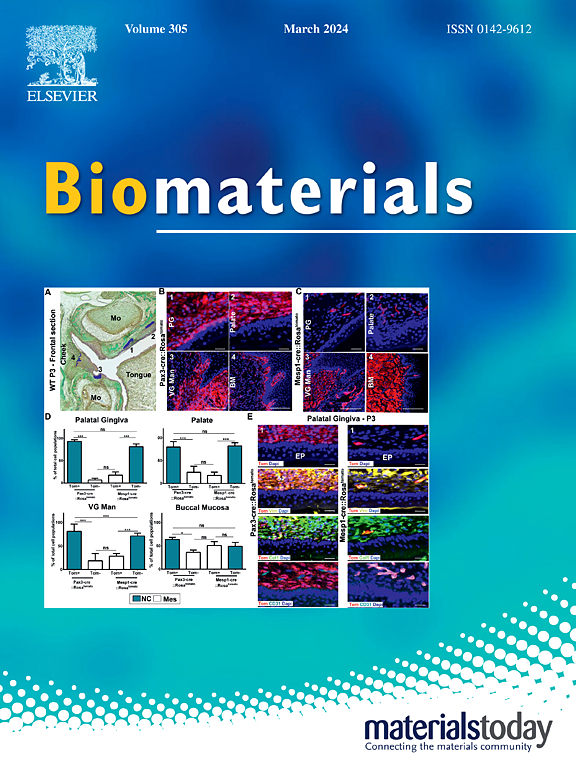微环境可激活纳米剂用于动脉再狭窄的实时NIR-II监测和靶向治疗
IF 12.8
1区 医学
Q1 ENGINEERING, BIOMEDICAL
引用次数: 0
摘要
动脉再狭窄是危及生命的心血管疾病的重要危险因素。精确的干预和实时监测非常重要,但仍然是主要的临床挑战。在这里,我们提出了一种先进的治疗纳米剂,它将缺氧反应的第二近红外(NIR-II)荧光成像与缺氧激活的抗增殖治疗相结合,用于实时诊断和精确治疗。该纳米平台是通过将一种新型的n -氧化物分子探针和一种可缺氧激活的前药替拉帕嗪(TPZ)共封装到骨桥蛋白(OPN)靶向脂质体中而构建的。在缺氧条件下,n-氧化物探针转化为其胺衍生物,改变分子内电荷转移性质并触发NIR-II荧光信号。这一特性使得高灵敏度、实时监测体内再狭窄病变成为可能。该纳米平台具有双重缺氧响应功能:TPZ在缺氧血管病变中选择性激活,抑制血管平滑肌细胞增殖;持续的opn介导靶向促进血管修复。在导丝诱导的再狭窄模型中,该系统通过NIR-II成像同时实时监测病变进展,在增强再内皮化的同时显著减少再狭窄。该研究为开发高性能治疗纳米平台提供了一种有前景的策略,可以精确检测和改善再狭窄相关疾病的治疗。本文章由计算机程序翻译,如有差异,请以英文原文为准。
Microenvironment-activatable nanoagent for real-time NIR-II monitoring and targeted therapy of arterial restenosis
Arterial restenosis is a critical risk factor for life-threatening cardiovascular diseases. Precise intervention and real-time monitoring are extremely important but remain major clinical challenges. Here, we present an advanced theranostic nanoagent that integrates hypoxia-responsive second near-infrared (NIR-II) fluorescence imaging with hypoxia-activatable anti-proliferative therapy for real-time diagnostics and precision treatment. This nanoplatform is constructed by co-encapsulating a novel N-oxide-based molecular probe and a hypoxia-activatable prodrug tirapazamine (TPZ) into osteopontin (OPN)-targeted liposomes. Under hypoxic conditions, the N-oxide probe undergoes conversion to its amine derivative, altering the intramolecular charge transfer properties and triggering turn-on NIR-II fluorescence signal. This property enables high-sensitivity, real-time monitoring of restenosis lesions in vivo. The nanoplatform exhibits dual hypoxia-responsive functionality: TPZ is selectively activated in hypoxic vascular lesions to inhibit vascular smooth muscle cell proliferation, and sustained OPN-mediated targeting promotes vascular repair. In guidewire-induced restenosis models, this system achieves simultaneous real-time monitoring of lesion progression via NIR-II imaging and significantly reduce restenosis while enhancing re-endothelialization. This study offers a promising strategy for developing high-performance theranostic nanoplatforms, enabling precise detection and improved treatment of restenosis-related diseases.
求助全文
通过发布文献求助,成功后即可免费获取论文全文。
去求助
来源期刊

Biomaterials
工程技术-材料科学:生物材料
CiteScore
26.00
自引率
2.90%
发文量
565
审稿时长
46 days
期刊介绍:
Biomaterials is an international journal covering the science and clinical application of biomaterials. A biomaterial is now defined as a substance that has been engineered to take a form which, alone or as part of a complex system, is used to direct, by control of interactions with components of living systems, the course of any therapeutic or diagnostic procedure. It is the aim of the journal to provide a peer-reviewed forum for the publication of original papers and authoritative review and opinion papers dealing with the most important issues facing the use of biomaterials in clinical practice. The scope of the journal covers the wide range of physical, biological and chemical sciences that underpin the design of biomaterials and the clinical disciplines in which they are used. These sciences include polymer synthesis and characterization, drug and gene vector design, the biology of the host response, immunology and toxicology and self assembly at the nanoscale. Clinical applications include the therapies of medical technology and regenerative medicine in all clinical disciplines, and diagnostic systems that reply on innovative contrast and sensing agents. The journal is relevant to areas such as cancer diagnosis and therapy, implantable devices, drug delivery systems, gene vectors, bionanotechnology and tissue engineering.
 求助内容:
求助内容: 应助结果提醒方式:
应助结果提醒方式:


